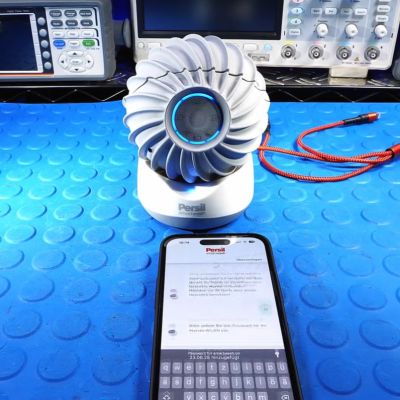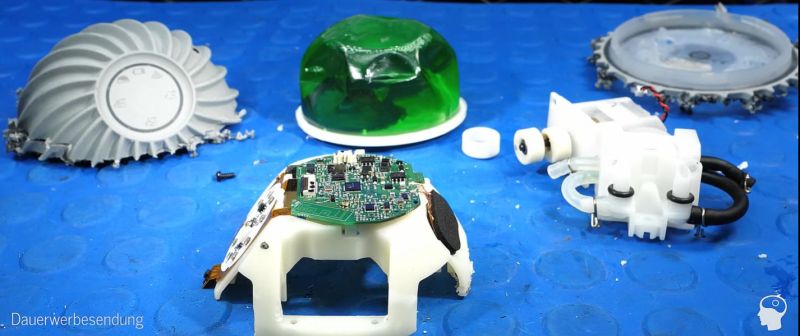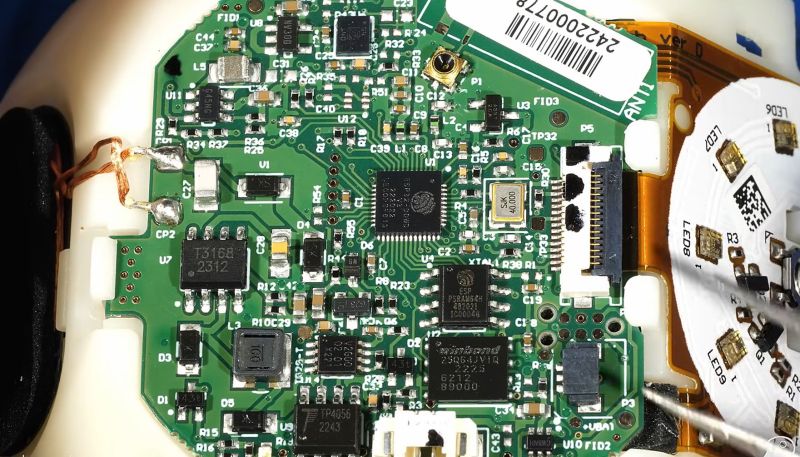
Ever since the invention of washing machines, the process of doing laundry has become rather straightforward. Simply toss the dirty laundry into the machine, fill up the detergent, and let the preset program handle the rest. This of course has not prevented companies from coming up with ways to add more complexity to doing laundry, with Henkel’s Smartwash technology the latest example, as demonstrated by German YouTube channel [ZeroBrain] with a complete teardown.
Henkel is the owner of detergent brands like Persil and Somat, with the Smartwash ball supposedly offering ‘smart’ dosing of detergent for washing machines, with naturally a smartphone app with intrusive localization to personalize the laundry experience. Sadly the video is only in German, but the language of teardowns is universal.
Before the teardown, the device got tested as intended, with the video showing how to put the detergent with its special pod inside the device. The device then got connected to WiFi, followed by it performing the typical IoT firmware update. After half an hour [Zerobrain] was finally ready to do the laundry. During the washing cycle the 441 gram heavy ball audibly bounced inside the machine, though the rubber outside covering should prevent damage.
The IP68-rated internals are clearly not designed to be easily opened, requiring a certain level of violence to correct for this oversight. Eventually the internals are revealed, showing the inductive charging coil, controls pad and main PCB, along with a pump for the double-chambered detergent pod and a bunch of sensors dangling at the end of flexible PCBs.

Interestingly, the heart of the main PCB is an ESP32-D0WD-V3, flanked by an ESP-PSRAMH 64 Mbit pseudo-static RAM. For charging the Li-ion cell a TP4056 is used, while a T3168 handles the wireless (Qi) power side of things. As for sensors, there are two Hall effect sensors that seem to be used to measure how much detergent and softener are being excreted by the pump.
What is fascinating is that it uses a single pump to pump both types of fluids independently from each other. There also appears to be a presence sensor to detect the presence of a pod, and some of the other ICs on the PCB may be an IMU to detect motion of the ball, but as hinted at in the accompanying app, you are still supposed to know the hardness of the local water supply and punch in the same details like laundry dirtiness that you’d normally read off the label on the detergent and softener packaging.
Thanks to [Jan Prägert] for the tip.
















Smart… wifi connected…. laundry detergent pods….
Which are actually full of well-engineered sensors and pumps, because that’s important when you’re dealing with … (checks notes) … laundry detergent.
Which itself comes in a specialized single-use cartridge…
You really should have saved this one for the April 1st “is this a real thing” edition, because reality is getting harder and harder to understand.
Sadly, reality is all too easy to understand here:
IoT is an excuse for companies to collect user data – capitalism at it’s finest.
A company coming out with something as utterly stupid and insanely wasteful as this deserves to be mocked. Alas they’ll probably just end up quietly killing it when they can’t find enough gullible idiots who want IoT soap.
I bet they have some nice waffle on their website about environmental responsibility too.
May I suggest a Hackaday Contest to celebrate products of this type? I’m thinking along the lines of “Most Stupid IOT Device Contest”
Qualified devices must (a) connect to the Internet or to a phone app that then connects to the internet (b) “personalize the user experience” (c) collect or transmit some kind of private information about the user while (d) providing no tangible benefit to the user that could not be provided by a non-IOT equivalent.
Bonus points if it contains lithium batteries. Bonus points if it’s constructed in a fashion rendering it non-repairable/non- recyclable.
Recommend listening to the Trashfuture podcast, especially episodes from the first few years. They open most episodes by skewering IoT gimmicks and tech startups.
Maybe with a honroable mention category where the IoT “like” device doesn’t need Internet (only local connection) and/or works with FEM/homeautomation (the open source smart home stacks – however they are called)
(forgot direct MQTT support(?))
Perhaps in the future, March 31st could be the one day of the year when Big Capital trolls us with products that aren’t totally f’ing stupid. It would give them a whole year to come up with something sensible and useful, without risk of having to make it, as they can just cancel it because it’s EOFY
I somehow doubt that thing would survive in the old-fashioned Borg-Warner coin-up double-capacity front loader that I used to have at the laundromat I worked at as a kid. Debatable whether it would tolerate the agitator in a Maytag A21 top-loader.
It would be assimilated.
Wait, what? ” fill up the detergent,”??
Every clothes washer I’ve ever used I just throw in the appropriate amount of detergent in the tub, before the clothes. There’s no place to “fill up”. Even a new one bought just last month.
Dishwasher, yes, they have a dispenser that needs to be filled with each wash.
Am I just n the wrong market segment for washing machines?
Many washers have a pre-wash cycle without suds, only then water is directed over a little cup with detergent in a pull out that gets flushed into the drum when it fills. A pod would get wet and quickly flushed out on the pre-wash, so a waste of product.
“Hi Maya, this is SmartWash! I noticed some new DNA in your laundry, and would like to tell you about a special offer to upgrade your oral contraceptives to a convenient subscription plan…..”
It’s not funny because it’s not funny.
wont work this with Maya :-}
Apparently Paul is not old enough to have used a washer with a detergent well and a bleach well. Hoity-toity families had fabric softener wells in their fancy washers.
Extra hoity-toity family member here, mine also has a well for softener.
You mean this stuff made from meat industry waste like animal tallow?
(Yeah, great stuff to get allergies (I think?))
In the UK and Europe where front-loaders are the norm they have a detergent drawer, you put detergent in the 1st slot, softener in the 2nd, sometimes there’s a 3rd for pre-wash detergent.
I don’t think I’ve ever seen a machine without a detergent drawer.
The standard washing machine in Europe for the past decades has been a frontloader with a drawer with sections that you put the detergent, softener and sometimes pre-wash and such into. These are then used by the washing machine during their respective part of the washing process.
All you need to do to get the right dose is to look up your local water hardness, cross-reference it with the handy table on the bottle of detergent, etc., and pour that amount into the drawer section. That makes this product so much more baffling as it basically partially automates that dosing process, while adding a whole lot more of things to worry about, such as keeping that ball charged and replacing pods.
As a semi-functioning adult who does laundry with a washing machine on a regular basis I am totally failing to see the use case that Henkel has in mind here, other than maybe to appeal to the ‘smart home’ crowd.
In the US, as well, the only washer I’ve ever used WITHOUT a detergent well was my family’s Kenmore top-loader 40 years ago, where you did indeed pour the detergent right over the clothing. But even THAT washer still had a softener dispenser mounted on top of the agitator, which would automatically add it later in the cycle.
All of the coin-op machines I’ve used have TWO detergent wells, because they run two wash cycles with a rinse in between.
Hmm. I guess I’m the wrong marketing demographic.
60 years ago it was a wringer machine, then a frontloader, then a succession of toploaders as I moved houses and left the old machine behind.
The last one, a month ago, is still a toploader, and not one of those machines in all those decades has ever had a detergent dispenser. You just put a scoop (or now, a sheet) of however much detergent you want in the tube, turn on the water and then add clothes.
And all but that last one has had exactly zero semiconductors in it. The new one still has a mechanical timer, but has LEDs.
All those machines were made in USA or Canada.
Walking through Home Despot I do see a lot of huge but dainty-looking Korean machines that have a bunch of drawers and displays and touch panels and wifi and subsrciptions, and all I see is future repair bills, unobtainium parts, and a short lifespan. And expensive “HE” detergent.
No thanks. I’ll stick with my bomb-proof old-school appliances.
People putting detergent in the dedicated compartment of their washing machine must be a horror to a multi billion company such as Henkel. They’d much rather have that you only use their specially chipped (for your own safety) pouches in their environment friendly washing balls.
Then wait a few years and washing detergent will be more expensive then printer ink.
Can you eat it, like Tide pods?
You can eat anything once.
Unless it eats you first.
What about stuff that eats you “from inside” -> In Soviet Russia some things you can eat eat you from inside out (afterwards).
(Maybe some Acids? Do some flesh eating bacteria count?)
I found the pump interesting — that would also be something for a cocktail robot to save on motors. One motor for two pumps with the one-way coupling is cool.
Cocktail robots tend to use peristaltic pumps to get the pumping action without the need of the fluid going through the pump
Cool… more e-waste products to improve a thing that doesn’t need further improvement.
As if the laundry business isn’t already a major polluter and now they are adding e-waste. A piece of shit with a battery (and an inductive charger always plugged in at a place where you don’t really have a power outlet to spare) all in a hump of plastic to be configured with an app and possibly in the future with a detergent at the same cost of printer ink (but now I’m speculating).
Yeah, I’d really love to put a half kilo lump of plastic into my washing machine.
It’s really “funny” how utterly crap every “smart” thing is with household appliances, including TVs. It sucks right at the beginning, and never gets updated.
It’s the same with cars. Please support CarPlay and Android Auto and don’t bother to invent your own smart functions.
It seems to be like that: PHBs say: “We need lock in, consumer data and control! Wrap it in smart functions and sell it as feature!”
“What? You want UX designers, app developers, and do regular updates? Money doesn’t grow on trees, you know!? We have interns that know how to switch on a computer, let them develop the crap and make sure data collection works, the rest is just fluff…”
Only for the grace of laziness that the Washing Machine companies haven’t followed the printer companies and allowed only “approved detergent” in their machines.
Fortunately this post constitutes Prior Art. You’re welcome.
It’s only prior art once either they try to patent it, or you do. If you just throw it out there and do nothing with it, they’re free to steal your idea and run with it for as long as it remains unpatented. And I really, really don’t want them getting ideas like that.
Also, why are we still using printer ink as the go-to, when Keurig has already trumped them by applying the same model to their preposterous coffee makers? Which, unlike printers, have a readily-available, completely manual alternative anyone can operate, and runs on low-cost bulk supplies? (Well, I suppose that’s also true for printers, technically. It’s called a typewriter and a box of crayons.)
+1 Internets for you!
Thanks for the lolz ;-)
The funny thing about that is, I’m old enough that back when I was in college and working at the campus computer labs, we had a couple of labs that offered color printing via some very high-end, at the time, Tektronix (now Xerox) Phaser III dye-sublimation machines.
They used solid ink supplies. Each of the four process colors came as these waxy sticks you’d drop into the reservoirs. The printer melted the ink and applied it to the page.
So, we actually had printers that ran on crayons. (In a sense.)
it’s already on the market:
https://www.miele.de/c/ultraphase-5007.htm
I avoid all IoT with wifi. I don’t need a full stack computer talking to the internet without me knowing about it. Its another vector into my network when an inevitable vulnerability comes up, and the company will likely never update the firmware. If I am forced too (because thats just the way it is these days). I have a completely private wireless network with no internet connection and I will pick out whats needed. That said, I avoid IoT wifi as much as possible and prefer zigbee or zwave. Less accessibility to outsiders and requires a gateway.
Into the garbage it goes.